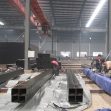Glass curtain wall node design
In order to adapt to the large-span common architectural modeling, the glass rib needs to be splicing to become a whole. The bending moment it receives is proportional to the square of the span of the rib. The larger the span, the greater the bending moment and shear force at the splicing. Attention should be paid to the design of curtain wall frame. Due to the characteristics of glass, it is not suitable to use the role between the connecting bolt and the glass hole wall, including adding a cushion or glue in the glass hole to improve the connection strength between the connecting plate and the glass facade. Splicing the glass floor can be used to press the interface material between the steel plate and the glass through bolts to improve the friction, so as to effectively fix the joint.

Therefore, it is best to use the method of adhesive bonding, that is, through the glass and steel plate with adhesive to transfer bending moment and shear force, the formation of strong connection. This method can effectively avoid the low bearing capacity of the curtain wall window caused by the stress concentration at the hole edge in the bolting mode. Another effective method is to use the silica gel plate or rubber plate as the interface material between the steel plate and the glass, and press the steel plate, silica gel plate or rubber plate and the glass by bolts to improve the friction, so as to effectively fix the curtain wall facade and the glass by the effect of friction. Attention should be paid to the design, such as the use of adhesive solutions to take into account. The linear expansion coefficient of stainless steel and glass is different, in addition to considering the transfer of internal force, the bonding surface should also consider the relative temperature displacement between the two materials. It has been proved by calculation that under the effect of 40℃ temperature difference between stainless steel and glass, the bonding edge stress has reached 80.8861Mpa, which is greater than the edge strength limit of tempered glass.
In this part is easy to appear due to the change of temperature difference caused by the curtain wall glazing. When different materials are combined, temperature difference stress should be considered, which is related to the difference of linear expansion coefficient and temperature change amplitude of materials. The linear expansion coefficient of glass is 1.0×10-5/C, the linear expansion coefficient of stainless steel plate is 1.8×10-5/C, and the linear expansion coefficient of steel plate is 1.2×10-5/C. Therefore, the use of steel plate and glass rib bonding can effectively reduce the adverse effects caused by temperature difference stress.
Tel: +86 18202256900 Email: steel@fwssteel.com










